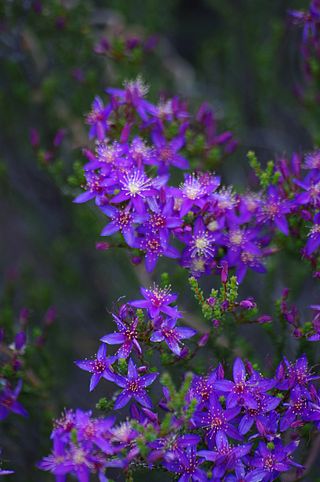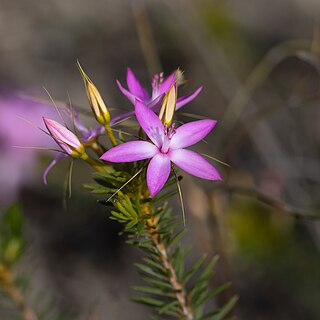
Calytrix depressa is a species of flowering plant in the myrtle family Myrtaceae and is endemic to the south-west of Western Australia. It is a glabrous shrub with linear to lance-shaped leaves and mauve to violet or yellow flowers with 35 to 75 stamens in several rows.

Calytrix leschenaultii is a species of flowering plant in the myrtle family Myrtaceae and is endemic to the Southwest Australia of Western Australia. It is a mostly glabrous shrub with egg-shaped, elliptic, lance-shaped or linear leaves and purple, mauve, violet or pink flowers with a white or yellow base, and 6 to 40 white or yellowish stamens.

Seringia integrifolia, commonly known as common firebush, is a species of flowering plant in the family Malvaceae and endemic to the south-west of Western Australia. It is a compact shrub, its new growth densely covered with star-shaped hairs, and has mostly narrowly leaves and many deep blue to purple flowers arranged in groups of 4 to 10.

Calytrix achaeta, commonly known as the white-flowered turkey bush, kerosene wood or fringe-myrtle, is a species of flowering plant in the myrtle family Myrtaceae and is endemic to north-western Australia. It is a shrub or tree with hairy branchlets, egg-shaped, linear or lance-shaped leaves, and white to cream-coloured flowers with 12 to 18 stamens in a single row.

Calytrix asperula, commonly known as brush starflower, is a species of flowering plant in the myrtle family Myrtaceae and is endemic to the south of Western Australia. It is a mostly glabrous shrub with linear to narrowly elliptic leaves and cream-coloured to yellow flowers with 40 to 60 yellow stamens in several rows.
Calytrix birdii is a species of flowering plant in the myrtle family Myrtaceae and is endemic to inland areas of Western Australia. It is a shrub with egg-shaped to more or less round leaves and clusters of purple flowers with 45 to 55 reddish-purple stamens in several rows.

Calytrix brevifolia is a species of flowering plant in the myrtle family Myrtaceae and is endemic to the west of Western Australia. It is a glabrous shrub with egg-shaped, linear, elliptic or more or less round leaves and clusters of pink to magenta flowers with about 40 to 90 yellow stamens in 4 rows.

Calytrix brownii, commonly known as the white turkeybush, is a species of plant in the myrtle family Myrtaceae and is endemic to northern Australia. It is an erect or prostrate shrub with linear to narrowly elliptic leaves and white to creamish, star-shaped flowers with about 18 to 25 white stamens in a single row.

Calytrix carinata is a species of flowering plant in the myrtle family Myrtaceae and is endemic to northern Australia. It is a more or less glabrous shrub with egg-shaped, elliptic, linear or lanceolate leaves and clusters of pink, pinkish purple, or reddish flowers with about 30 to 50 pink and yellowish white stamens in two rows.

Calytrix creswellii is a species of flowering plant in the myrtle family Myrtaceae and is endemic to inland areas of Western Australia. It is a spreading, glabrous shrub usually with egg-shaped leaves with the narrower end towards the base, and clusters of white flowers with about 40 to 55 white or yellow stamens in several rows.

Calytrix decandra, commonly known as pink starflower, is a species of flowering plant in the myrtle family Myrtaceae and is endemic to the south of Western Australia. It is a semi-prostrate, glabrous shrub with linear to narrowly elliptic leaves and pink, mauve or magenta flowers with usually 10 stamens in a single row.

Calytrix desolata is a species of flowering plant in the myrtle family Myrtaceae and is endemic to the western regions of Western Australia. It is a glabrous shrub with linear oblong or lance-shaped leaves with the narrower end towards the base, and pink to purple flowers with about 30 to 60 stamens in several rows.

Calytrix fraseri, commonly known as pink summer calytrix or pink summer starflower, is a species of flowering plant in the myrtle family Myrtaceae and is endemic to the south-west of Western Australia. It is a shrub with oblong, linear or elliptic leaves with the narrower end towards the base, and pink, cerise or pinkish purple flowers with about 35 to 55 stamens in several rows.
Calytrix harvestiana is a species of flowering plant in the myrtle family Myrtaceae and is endemic to the west of Western Australia. It is a glabrous shrub with linear, elliptic or egg-shaped leaves and purplish mauve to purple or violet flowers with about 60 to 70 pale yellow stamens in multiple rows.

Calytrix sapphirina is a species of plant in the myrtle family Myrtaceae that is endemic to Western Australia.

Stachystemon polyandrus is a species of flowering plant in the family Picrodendraceae and is endemic to the southwest of Western Australia. It is a diffuse to straggling, monoecious shrub with crowded, oblong, elliptic or egg-shaped leaves with the narrower end towards the base, and small yellowish-white flowers arranged singly in upper leaf axils, but forming clusters at the ends of branches.

Calytrix arborescens is a species of flowering plant in the myrtle family Myrtaceae and is endemic to the Northern Territory. It is a shrub or tree with egg-shaped leaves and clusters of white flowers with 45 to 60 white stamens in 2 rows.

Calytrix glaberrima, commonly known as smooth fringe-myrtle, is a species of flowering plant in the myrtle family Myrtaceae and is endemic to the south of South Australia. It is a woody, glabrous shrub with elliptic, linear or egg-shaped leaves and clusters of white to pink flowers with 20 to 30 white stamens in a single row.

Calytrix leptophylla is a species of flowering plant in the myrtle family Myrtaceae and is endemic to Queensland. It is a glabrous shrub with linear leaves, and pink to light purple flowers with a white base, and about 35 to 40 white to yellow stamens in several rows.

Calytrix longiflora, commonly known as pink fringe myrtle, is a species of flowering plant in the myrtle family Myrtaceae and is endemic to eastern Australia. It is a shrub with egg-shaped to narrowly lance-shaped leaves with the narrower end towards the base, and pink to mauve flowers with about 35 to 65 yellowish stamens in several rows.

















